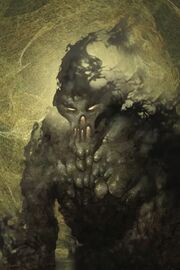| “ | Be honored, Percy Jackson. Lord Zeus rarely allows me to test a hero with one of my brood. For I am the Mother of Monsters, the terrible Echidna! | ” |
–Echidna to Percy Jackson, in The Lightning Thief | ||
Echidna is the daughter of Phorcys and Keto, and is considered the mother of all monsters in Greek mythology. Typhon is her husband.
History
Hesiod described Echidna as a female monster spawned in a cave, who mothered, with her mate Typhon, almost every major and minor horrible monster in the Greek myths. Echidna was usually considered an offspring of Tartarus and Gaea, or of Ceto and Phorcys (according to Hesiod) or of Chrysaor and the naiad Callirhoe, or Peiras and Styx (according to Pausanias, who did not know who Peiras was aside from her father). Echidna was a dracaenae, with the face and torso of a beautiful woman (depicted as winged in archaic vase-paintings) and the body of a serpent, sometimes having two serpent's tails. She is also sometimes described as Karl Kerenyi noted an archaic vase-painting with a pair of echidnas performing sacred rites in a vineyard, while on the opposite side of the vessel, goats were attacking the vines: thus chthonic Echidnae are presented as protectors of the vineyard.
The site of her cave Homer calls "Arima, couch of Typhon." When she and her mate attacked the Olympians, Zeus beat them back and punished Typhon by sealing him under Mount Etna. However, Zeus allowed Echidna and her children to live as a challenge to future heroes. She was an immortal and ageless nymph to Hesiod (Theogony above), but was killed where she slept by Argus, the hundred-eyed giant.
Percy Jackson and the Olympians
The Lightning Thief

Typhon, her husband
While Percy Jackson, Annabeth Chase, and Grover Underwood are at the top of the Gateway Arch, they encounter Echidna, who also has the Chimera with her (the latter being in the form of a chihuahua because of the Mist). She quickly isolates Percy from his friends while he is waiting for a second empty elevator, as the first was full, and pits him against her monstrous son at the top of the arch. She becomes infuriated after he confuses her with the anteater species in Australia. Percy barely manages to escape after being poisoned by the Chimera's snake tail and plummets into the water below, to the taunts of Echidna, but while in the water his injury is healed. It is unknown where Echidna went after attacking Percy on the arch.
The Last Olympian
When Hermes references the fact that Typhon is the husband of Echidna, Percy says that he "met her on the arch, not nice," referring to him meeting her in The Lightning Thief.
Appearance
In the book, Echidna is described through the Mist as an extremely fat woman in a denim dress with a fearsome chihuahua that is her son the Chimera. The only clues that she was a monster were her reptilian tongue, the fact that she called her dog "Sonny" (which Percy thought was its name at first) and the fact that she has slitted eyes like a snake.
When she is her true form, she still has a human head, but a snake-like body. Her tongue is forked and has fangs instead of teeth. Her skin and eyes also resemble to a reptile's as her eyes are sideways slits and her skin is bright green and scaly.
Children
- Cerberus
- Chimera
- Clazmonian sow
- Drakon
- Sphinx
- Nemean lion
- Hydra
- Ladon (some accounts)
- Manticore (possibly)
- Orthrus
- Scylla (some accounts)
- Sybaris (possibly)
- Charybdis (some accounts)
Grandchildren
- Hellhounds
Trivia
- Echidna and Kampê are sometimes thought to be the same monster.
- Sphinx is the only monster in the series whose mother is Echidna but whose father is not Typhon.
- She, along with Chimera, are a few of the only monsters that appear in the series that are not defeated and sent to Tartarus.
- While Echidna is called "The Mother of All Monsters", there are several monsters in the series and in Greek Mythology that are not her children. The title may only be an "honorary" title of Echidna given the sheer number of monsters that she had with Typhon.
